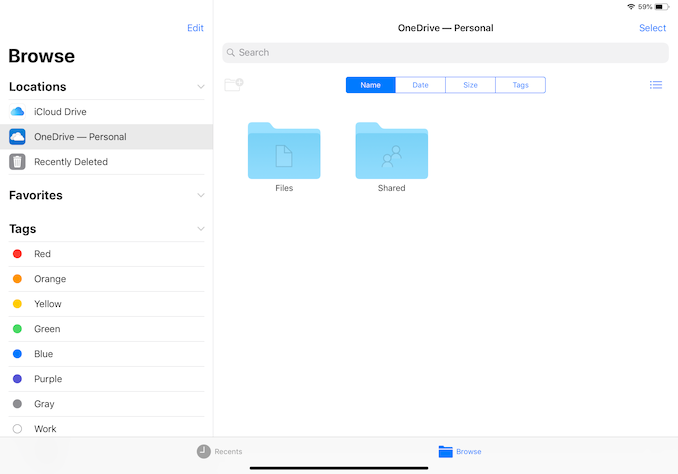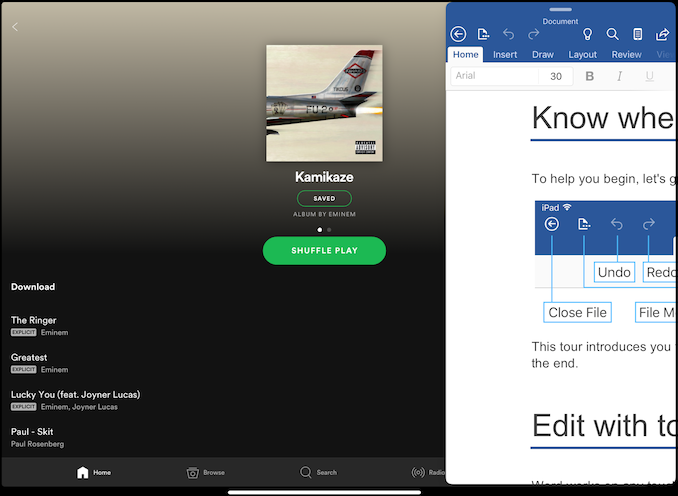The 2018 Apple iPad Pro (11-Inch) Review: Doubling Down On Performance
by Brett Howse & Andrei Frumusanu on December 4, 2018 10:00 AM ESTWireless
Apple has stuck with the same wireless solution as they offer in the iPhone, which is the Murata/Apple 339S00551 Wi-Fi controller. This is an 802.11ac 2x2:2 solution with 80 MHz channel support, and it integrated Bluetooth 5.0. The actual controller is likely a Broadcom unit, which is what Apple tends to use in its iOS devices.
Unfortunately, iOS doesn’t let us perform our standard copy script to provide peak throughput testing, so we can’t comment on that, however the iPad did lose connection the access point several times and would require a device restart to connect again. Switching to a different access point corrected this issue, but was a less than ideal solution.
On the cellular side, Apple has outfitted the LTE versions with Intel’s XMM 7560 modem, which offers Category 16 downloads.
Audio
As mentioned in the design section, the iPad Pro features four sets of speakers, with both a tweeter and woofer for each corner. There are drilled holes in the aluminum chassis to let the sound out, and the iPad offers dynamic audio based on its rotation so that the left and right channels of audio are directed to the correct side. If you turn the iPad 180°, the left and right channels will switch to keep the stereo correct. It is a great system that works flawlessly.
The actual speakers on the iPad sound very good, and on playback of a test track, were able to achieve around 85 dB(A) measured one inch over the device. There is no distortion, and the speaker range was quite good for a small device.
The bad news is if you want to connect your favorite headphones to the iPad, there is no longer a 3.5 mm jack. The reasoning behind the removal on the iPhone was due to space concerns, but on a larger device like the iPad, that seems like a weak argument. In addition, there’s no 3.5 mm USB-C adapter in the box either, so if you do want to use wired headphones, you’ll need to purchase an adapter. This is obviously less than ideal.
Cameras
Apple offers a 7 MP front facing camera with f/2.2, Smart HDR, wide color support, and "Retina Flash", which means it will use the display as a flash for the front facing camera. The front facing camera works well for Face Time, which is what it is really designed for, although the location of the camera in the top bezel in portrait means that it won’t work well in landscape, since everything is off-center. Ideally, Apple could offer two sets of cameras, which would also help out with Face ID.
The rear camera is a 12 MP f/1,8 with PDAF, Smart HDR, wide color support, and True Tone Quad-LED flash.
The rear camera is quite good, likely on-par with the iPhone XR.
![]()
Google Pixel XL camera samples
Due to the weather (it’s winter in Canada) the only samples here are from indoor shots compared against the Google Pixel XL.
Software
As I mentioned towards the start of this review, as Apple is pitching the iPad Pro as a professional productivity machine, I opted to go into this review focusing on just that. Meaning the competition for the iPad Pro isn't so much other ARM-based tablets, but rather similarly-capable business machines like the Surface Pro series or Lenovo's various Yoga devices. At this point I don't think the iPad Pro's pedigree in terms of hardware is in question. But rather it's a question of whether the software can do everything that a professional machine should be able to. The iPad is inseparable from iOS, for all the benefits and drawbacks that can bring.
Apple wants the iPad Pro to be a professional, or at least prosumer, level of device. And in order to achieve that they need not only the operating system, but also the applications available for people to get work done. The iPad’s success over the years was always offering easy access to content, but only in the last couple of generations has Apple put serious effort into letting people get work done on it via the iPad Pro family.
 The Files app doesn't provide access to any files on the device
The Files app doesn't provide access to any files on the device
iOS has come a long way in terns of its ability to multitask, but with the gesture based navigation it can be a bit cumbersome to switch applications on the fly. Over time, you do get better at it, but it still doesn’t compare to the PC. The four-finger swipe to switch between open applications is quick, but if you have several open it can be slow to get where you need to go. iOS 12 of course still supports the Split View and Slide Over modes as well. There’s also no file system access, other than the rudimentary Files application, and Apple has decided not to allow regular USB drives to be connected and used to transfer media. You can hook up a camera card and import the photos, and there are various iOS-specific drives out there that work on an application-by-application basis, but the only way to move the files off of the iPad is generally through the cloud.
 Since iOS requires the app developers to explicitly support their multitasking modes, if you want Word open with Spotify at the same time, this is your only option
Since iOS requires the app developers to explicitly support their multitasking modes, if you want Word open with Spotify at the same time, this is your only option
What it boils down to is that the iPad Pro offers a tremendous amount of performance, but at this point it feels held back by iOS. If you have a workflow that you know works well in iOS, it will almost certainly work better on the iPad Pro. But if you have a workflow from the PC, that will need to be adjusted to make it fit the iPad.
That’s not necessarily a bad thing. There are clearly people who can not only make the iPad work, but find it to be a better tool than what they had in the past, but that is not always the case. With more professional applications coming to iOS, this could improve over time as well, and Adobe in particular has been a strong supporter of iOS with their Creative Cloud applications.
Other features are also left wanting, such as the ability to hook the iPad Pro up to a 5K display over USB-C. At the OS level the only option here is to mirror the iPad display, but since the display you are connecting to likely doesn’t offer touch, and there’s no pointer support in iOS, it literally is just a cropped version of the iPad display on another screen. Apps can take advantage of the second display, such as a presentation which would offer a different experience on both displays, but it doesn’t offer the flexibility of the PC or Mac with regards to connecting extra monitors.
There are hundreds of small issues like this that you’ll run into when using iOS for professional-level productivity. Some of them will be real issues, and some of them will just be re-learning tasks. There’s no doubt you can get work done on the iPad Pro, but the question is if you can do it as efficiently as you are used to. If you can, great. This iPad is for you.













145 Comments
View All Comments
thunng8 - Wednesday, December 5, 2018 - link
Yes, way ahead of Core M, especially for graphics. Something like 5-6X faster in gfxbench.Brett Howse - Wednesday, December 5, 2018 - link
There's a few results in there already from the MacBook Air with Y Series.name99 - Wednesday, December 5, 2018 - link
The most interesting thing, to me, is the cache topology.While everyone else at the high end has been retreating to private L2 caches, and a large shared L3, Apple has doubled down on a
- LARGE L2 that's
- shared by at least 4 clients
with L3 acting more as the communications/sharing space between different blocks like CPU, GPU, ISP, NPU.
Clearly it's working for them! It also suggests that when they scale even larger (the inevitable ARM Macs and [internal use] servers) they'll likely ship something that looks very different from not just Intel's high end (private L2, distributed L3 slice per core) but perhaps also the current ARM servers?
Do we know anything at all about the NoC that's in use on Apple SoCs, and, second best, on other ARM SoCs (eg QC, Samsung)? A ring? A crossbar? Point to point with direct links from each block to L3, but no block-to-block communication?
Railgun - Wednesday, December 5, 2018 - link
These reviews lately are killing me. Zero consistency from chart to chart. Why in one metric are we comparing a tablet to phones, and others to other tablets...and nada against its predecessor? There are so many reviews like this.Brett Howse - Wednesday, December 5, 2018 - link
Some of the tests are mobile only.Some of the tests are not.
This device bridges both so why would we not compare it to both?
Socius - Wednesday, December 5, 2018 - link
Charging time with a proper adapter is insanely fast on the iPad pro. Using a 20,000mah battery pack, I was able to charge it up from 3% to 45% in about 30-35 minutes. That is absolutely incredible.Also, you can change the tip on the Apple Pencil as it is a simple screw off design. Apple itself doesn't sell different tips but I'm sure 3rd party would step in pretty soon.
One thing you didn't cover is the disk read/write performance. And it differs greatly based on which model iPad you get. The 12.9" 1TB WiFi model is substantially faster than other capacities. And the extra ram has helped keep apps/games in memory far longer than they would on my XS Max with its 4GB ram.
We'll be able to better compare the productivity performance of the iPad Pro once the full Photoshop CC port is released in 2019. But in the mean time, I'm editing through 4K videos using LumaFusion like it's nothing. This isn't a desktop. But with the right apps, it can come pretty close to being able to handle 90% of your workflow. In such a small and portable package. I find myself designing websites on it while sitting on the couch. The drag-and-drop feature between application windows in split view is such a big help as well.
Overall, I picked the iPad Pro over the Surface Pro due to the 120Hz display. And once Photoshop is ported over in a few months, I'll be able to do so much more of my work on it. I think my only gripe is that Microsoft Office is so weak on the iPad Pro. If only I had access to the full desktop version.
lilo777 - Wednesday, December 5, 2018 - link
1. Don't work on your couch.2. iPad does not have 120Hz display
darklight69 - Thursday, December 6, 2018 - link
1. He/She can work wherever they feel like. What kind of control freak are you to demand otherwise from complete strangers.2. Yes it does, says so in the review's display section - https://www.anandtech.com/show/13661/the-2018-appl...
"In addition, Apple’s iPad Pro offers their ProMotion technology, which means it is a 120 Hz display, but one that supports variable refresh rates in order to lower the display's refresh rate for power management purposes."
WasHopingForAnHonestReview - Wednesday, December 5, 2018 - link
Nonsense. How much are you paid for this co?mmentSocius - Thursday, December 6, 2018 - link
Which part of what I said do you disagree with or find questionable?